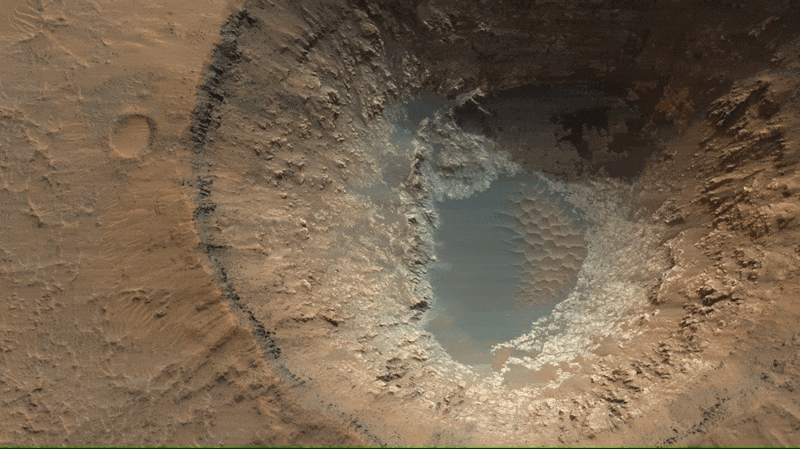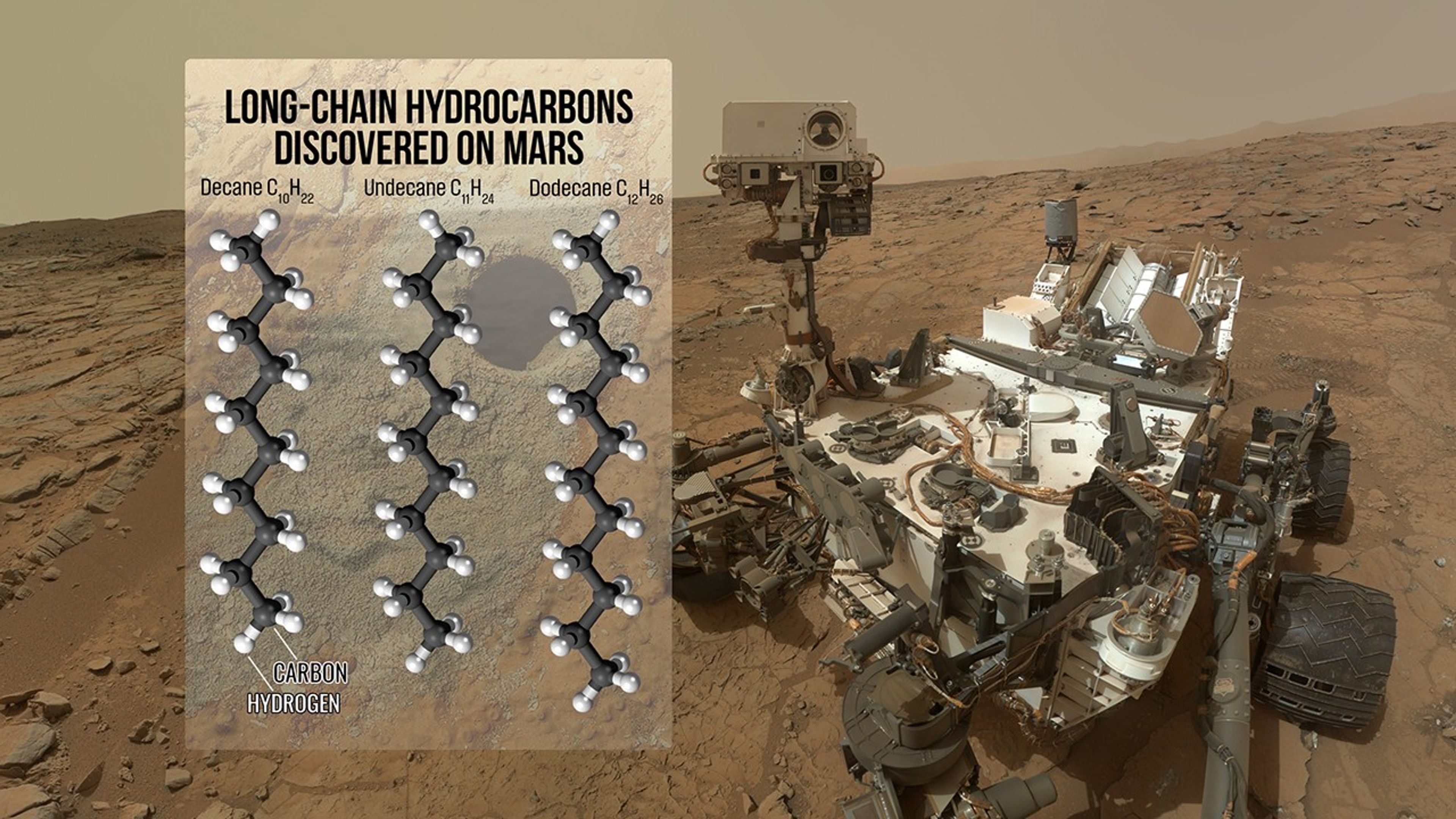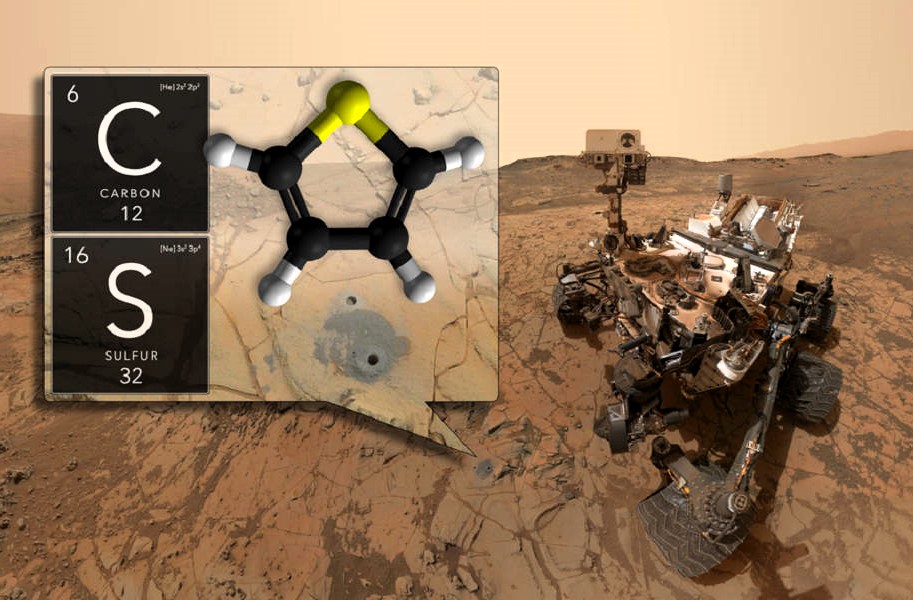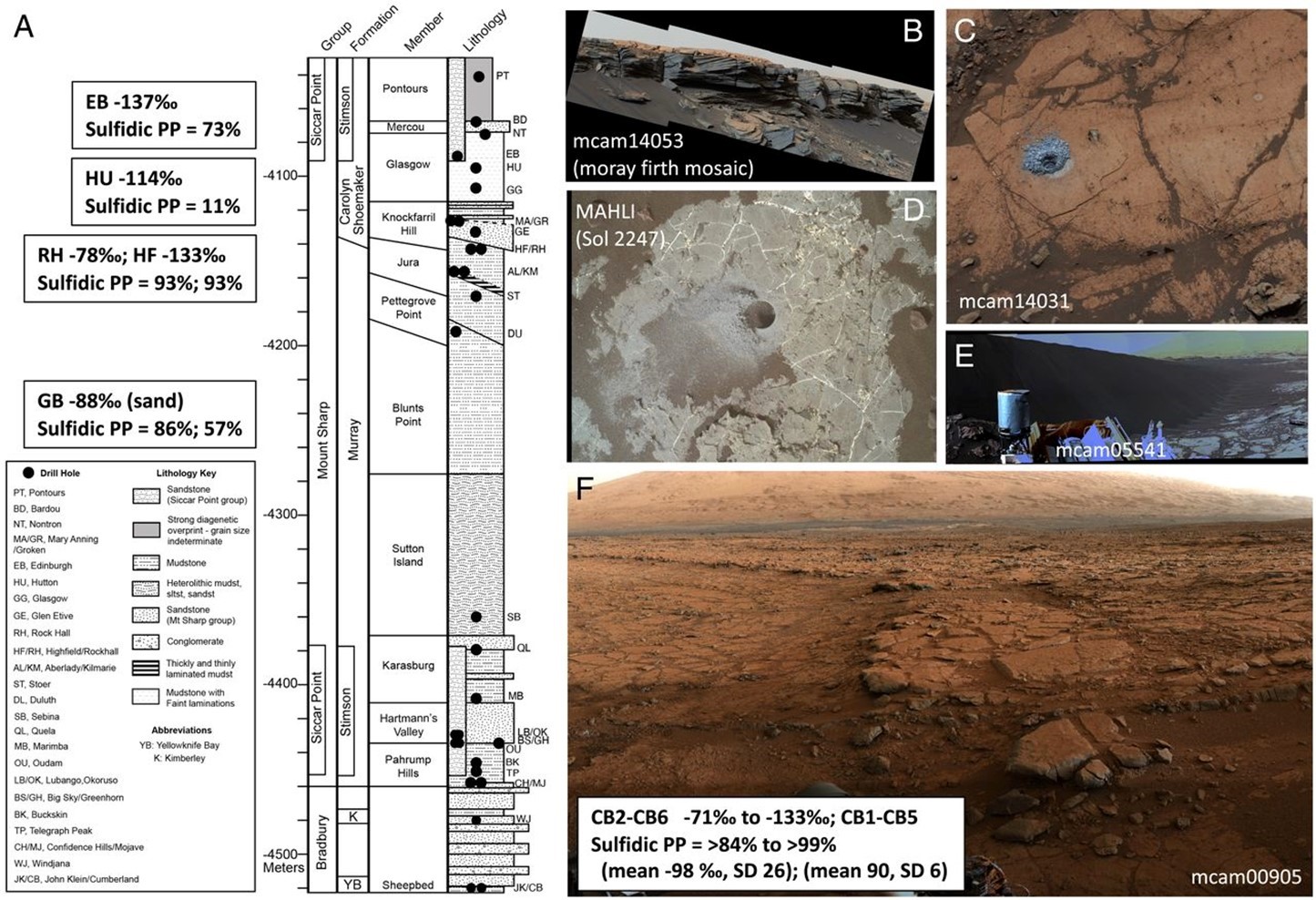NASA'nın ‘Curiosity’ uzay aracındaki örnekleme cihazı tarafından önemli bir keşfe kapıları araladı. Mars’ta Fransız Ulusal Bilimsel Araştırma Merkezi'nde (CNRS) görevli analitik kimyager Caroline Freissinet tarafından yürütülen araştırmanın sonucu dikkat çekti.
NASA'nın Curiosity gezginindeki toz haline getirilmiş kayayı analiz eden araştırmacılar, Kızıl Gezegen'de bugüne kadarki en büyük organik bileşikleri buldular. Pazartesi günü Proceedings of the National Academy of Sciences'da yayınlanan bulgu, prebiyotik kimyanın Mars'ta daha önce gözlemlenenden daha fazla ilerlemiş olabileceğini öne sürüyor.
Bilim insanları Curiosity'nin Mars'taki Örnek Analizi (SAM) mini laboratuvarında mevcut bir kaya örneğini incelediler ve dekan, undekan ve dodekan moleküllerini buldular. Sırasıyla 10, 11 ve 12 karbondan oluşan bu bileşiklerin, örnekte korunan yağ asitlerinin parçaları olduğu düşünülüyor. (Yağ asitleri, Dünya'da yaşamın kimyasal yapı taşları olan organik moleküller arasındadır.)
Canlılar, hücre zarlarının oluşumuna yardımcı olmak ve çeşitli diğer işlevleri yerine getirmek için yağ asitleri üretir. Ancak yağ asitleri, hidrotermal bacalardaki suyun minerallerle etkileşimi de dahil olmak üzere çeşitli jeolojik süreçler tarafından tetiklenen kimyasal reaksiyonlar yoluyla yaşam olmadan da üretilebilir.
Belirlenen moleküllerin kaynağını doğrulamanın bir yolu olmasa da, bunları bulmak Curiosity'nin bilim ekibi için birkaç nedenden dolayı heyecan verici.
Curiosity bilim insanları daha önce Mars'ta küçük, basit organik moleküller keşfetmişti; ancak bu daha büyük bileşiklerin bulunması, organik kimyanın Mars'ta yaşamın kökeni için gereken karmaşıklığa doğru ilerlediğine dair ilk kanıtı sağlıyor.
Bu grafik uzun zincirli organik moleküller dekan, undekan ve dodekanı göstermektedir. Bunlar Mars'ta bugüne kadar keşfedilen en büyük organik moleküllerdir. NASA'nın Curiosity gezgininin göbeğinin içindeki Mars Laboratuvarı'ndaki Örnek Analizi tarafından analiz edilen "Cumberland" adlı delinmiş bir kaya örneğinde tespit edilmişlerdir. Selfie'si görüntünün sağ tarafında bulunan gezgin, 2012'den beri Gale Krateri'ni araştırmaktadır. Cumberland sondaj deliğinin bir görüntüsü molekül zincirlerinin arka planında belli belirsiz görülmektedir.
Grafiği buradan indirin: https://svs.gsfc.nasa.gov/14808/#media_group_377732
Yeni çalışma ayrıca, yalnızca yaşamın varlığında üretilebilen ve "biyoimzalar" olarak bilinen büyük organik moleküllerin Mars'ta korunabilme şansını artırıyor ve bu tür bileşiklerin onlarca milyon yıl yoğun radyasyona ve oksidasyona maruz kaldıktan sonra yok olma tehlikesiyle karşı karşıya olduğu yönündeki endişeleri ortadan kaldırıyor.
Bilim insanları, bu bulgunun Mars'tan Dünya'ya numune getirilip burada bulunan en gelişmiş cihazlarla analiz edilmesi planları açısından iyiye işaret olduğunu söylüyor.
Fransa'nın Guyancourt kentindeki Atmosfer ve Uzay Gözlemleri Laboratuvarı'ndaki Fransız Ulusal Bilimsel Araştırma Merkezi'nde araştırma bilimcisi ve baş yazar olan Caroline Freissinet , "Çalışmamız, bugün bile Mars örneklerini analiz ederek, Mars'ta daha önce var olmuşsa geçmiş yaşamın kimyasal izlerini tespit edebileceğimizi kanıtlıyor" dedi.
2015 yılında Freissinet, ilk kez, mevcut çalışmada kullanılan aynı örnekte Mars organik moleküllerini kesin olarak tanımlayan bir ekibin eş liderliğini yaptı. "Cumberland" lakaplı örnek, farklı teknikler kullanılarak SAM ile birçok kez analiz edildi.
NASA'nın Curiosity keşif aracı, keşif aracının Mars'taki çalışmasının 279. Mars günü veya solunda (19 Mayıs 2013) bu kaya hedefine, "Cumberland"a deldi ve kayanın içinden toz halinde bir malzeme örneği topladı. Curiosity, keşif aracının kolundaki Mars Hand Lens Imager kamerasını kullanarak, deliğin açıldığı aynı sol'de Cumberland'daki deliğin bu görüntüsünü yakaladı. Deliğin çapı yaklaşık 0,6 inçtir. Deliğin derinliği yaklaşık 2,6 inç ( 6,604 santimetre)
Curiosity, Cumberland örneğini Mayıs 2013'te Mars'ın Gale Krateri'nde "Yellowknife Koyu" adı verilen bir bölgeden deldi. Bilim insanları, eski bir göl yatağına benzeyen Yellowknife Koyu'ndan o kadar etkilendiler ki, keşif aracını oraya gönderip ardından kraterin tabanından yükselen Mount Sharp'ın birincil varış noktasına doğru ters yöne doğru yola çıktılar.
Yoldan sapmaya değdi: Cumberland, Gale Krateri'nin 3,7 milyar yıllık geçmişine dair baştan çıkarıcı kimyasal ipuçlarıyla dolup taşıyor. Bilim insanları daha önce numunenin suda oluşan kil mineralleri açısından zengin olduğunu bulmuşlardı. Organik molekülleri korumaya yardımcı olabilen bol miktarda kükürt içeriyor. Cumberland ayrıca Dünya'da bitki ve hayvanların sağlığı için elzem olan çok sayıda nitrat ve Dünya'da biyolojik süreçlerle ilişkilendirilen bir karbon türüyle yapılan metan içeriyor.
Belki de en önemlisi, bilim insanları Yellowknife Körfezi'nin gerçekten de eski bir gölün yeri olduğunu ve organik molekülleri yoğunlaştırıp çamur taşı adı verilen ince taneli tortul kayaçta koruyabilecek bir ortam sağladığını tespit ettiler.
Maryland, Greenbelt'teki NASA Goddard Uzay Uçuş Merkezi'nde örnek dönüşlerinden sorumlu kıdemli bilim insanı ve çalışmanın ortak yazarlarından Daniel Glavin , "Gale Krateri'nde milyonlarca yıl ve muhtemelen daha uzun süre sıvı suyun var olduğuna dair kanıtlar var. Bu da Mars'taki bu krater-göl ortamlarında yaşam oluşturan kimyanın oluşması için yeterli zaman olduğu anlamına geliyor." dedi.
Son organik bileşiklerin keşfi, Cumberland'ı proteinlerin yapı taşları olan amino asitlerin belirtileri için araştırmak üzere yapılan ilgisiz bir deneyin yan etkisiydi. Örneği SAM'in fırınında iki kez ısıttıktan ve daha sonra salınan moleküllerin kütlesini ölçtükten sonra, ekip amino asitlere dair hiçbir kanıt görmedi. Ancak örneğin az miktarda dekan, undekan ve dodekan saldığını fark ettiler.
Bu bileşikler ısıtma sırasında daha büyük moleküllerden kopmuş olabileceğinden, bilim insanları bunların hangi yapılardan gelmiş olabileceğini anlamak için geriye doğru çalıştılar. Bu moleküllerin sırasıyla undekanoik asit, dodekanoik asit ve tridekanoik asit yağ asitlerinin kalıntıları olduğunu varsaydılar.
Bilim insanları tahminlerini laboratuvarda test ettiler, undekanoik asidi Mars benzeri bir kile karıştırdılar ve SAM benzeri bir deney gerçekleştirdiler. Isıtıldıktan sonra undekanoik asit tahmin edildiği gibi dekan saldı. Araştırmacılar daha sonra undekanın dodekanoik asitten ve dodekanın tridekanoik asitten kopmuş olabileceğini göstermek için diğer bilim insanları tarafından daha önce yayınlanmış deneylere atıfta bulundular.
Yazarlar, örnekteki varsayılan yağ asitlerini oluşturan karbon atomlarının sayısıyla ilgili çalışmalarında ek bir ilgi çekici ayrıntı buldular. Her yağ asidinin omurgası, moleküle bağlı olarak 11 ila 13 karbondan oluşan uzun, düz bir zincirdir. Özellikle, biyolojik olmayan süreçler tipik olarak 12'den az karbonlu daha kısa yağ asitleri üretir.
Bilim insanları, Cumberland örneğinin daha uzun zincirli yağ asitleri içermesinin mümkün olduğunu, ancak SAM'ın daha uzun zincirleri tespit edecek şekilde optimize edilmediğini söylüyor.
Bilim insanları, nihayetinde Mars'a gönderilebilecek molekül avcısı araçlardan çıkarım yapabilecekleri şeylerin bir sınırı olduğunu söylüyor. Glavin, "Bir sonraki büyük adımı atmaya ve Mars örneklerini laboratuvarlarımıza getirip Mars'taki yaşam hakkındaki tartışmayı sonlandırmaya hazırız" dedi.
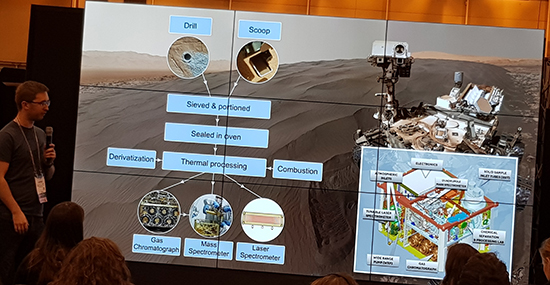
ENGLİSH NEWS
NASA’s Curiosity Rover Detects Largest Organic Molecules Found on Mars
Researchers analyzing pulverized rock onboard NASA’s Curiosity rover have found the largest organic compounds on the Red Planet to date. The finding, published Monday in the Proceedings of the National Academy of Sciences, suggests prebiotic chemistry may have advanced further on Mars than previously observed.
Scientists probed an existing rock sample inside Curiosity’s Sample Analysis at Mars (SAM) mini-lab and found the molecules decane, undecane, and dodecane. These compounds, which are made up of 10, 11, and 12 carbons, respectively, are thought to be the fragments of fatty acids that were preserved in the sample. Fatty acids are among the organic molecules that on Earth are chemical building blocks of life.
Living things produce fatty acids to help form cell membranes and perform various other functions. But fatty acids also can be made without life, through chemical reactions triggered by various geological processes, including the interaction of water with minerals in hydrothermal vents.
While there’s no way to confirm the source of the molecules identified, finding them at all is exciting for Curiosity’s science team for a couple of reasons.
Curiosity scientists had previously discovered small, simple organic molecules on Mars, but finding these larger compounds provides the first evidence that organic chemistry advanced toward the kind of complexity required for an origin of life on Mars.
The image features a rover with its robotic arm and various instruments visible on a rocky, reddish-brown terrain. In the background is a barren landscape with scattered rocks and hills under a hazy sky. Overlaying the left side of the image is a semi-transparent panel with the title "Large Organics on Mars" in bold black letters. Below the title, three molecular chains are displayed, consisting of black spheres representing carbon atoms and white spheres representing hydrogen atoms. Labels indicate "carbon" as the black spheres and "hydrogen" as the white spheres. A faint circular blur appears in the background of the panel.
This graphic shows the long-chain organic molecules decane, undecane, and dodecane. These are the largest organic molecules discovered on Mars to date. They were detected in a drilled rock sample called “Cumberland” that was analyzed by the Sample Analysis at Mars lab inside the belly of NASA’s Curiosity rover. The rover, whose selfie is on the right side of the image, has been exploring Gale Crater since 2012. An image of the Cumberland drill hole is faintly visible in the background of the molecule chains.
Download graphichere: https://svs.gsfc.nasa.gov/14808/#media_group_377732
The new study also increases the chances that large organic molecules that can be made only in the presence of life, known as “biosignatures,” could be preserved on Mars, allaying concerns that such compounds get destroyed after tens of millions of years of exposure to intense radiation and oxidation.
This finding bodes well for plans to bring samples from Mars to Earth to analyze them with the most sophisticated instruments available here, the scientists say.
“Our study proves that, even today, by analyzing Mars samples we could detect chemical signatures of past life, if it ever existed on Mars,” said Caroline Freissinet, the lead study author and research scientist at the French National Centre for Scientific Research in the Laboratory for Atmospheres and Space Observations in Guyancourt, France
In 2015, Freissinet co-led a team that, in a first, conclusively identified Martian organic molecules in the same sample that was used for the current study. Nicknamed “Cumberland,” the sample has been analyzed many times with SAM using different techniques.
This animated image shows a close-up view of a flat, dusty, tan-colored rock surface with fine cracks and small, dark specks scattered across it. In the animation, a hole appears in the center of the frame, with loose powdered material surrounding the hole. The surrounding rock surface remains unchanged, highlighting the freshly drilled hole and the fine texture of the rock.
NASA's Curiosity rover drilled into this rock target, "Cumberland," during the 279th Martian day, or sol, of the rover's work on Mars (May 19, 2013) and collected a powdered sample of material from the rock's interior. Curiosity used the Mars Hand Lens Imager camera on the rover’s arm to capture this view of the hole in Cumberland on the same sol as the hole was drilled. The diameter of the hole is about 0.6 inches. The depth of the hole is about 2.6 inches.
Curiosity drilled the Cumberland sample in May 2013 from an area in Mars’ Gale Crater called “Yellowknife Bay.” Scientists were so intrigued by Yellowknife Bay, which looked like an ancient lakebed, they sent the rover there before heading in the opposite direction to its primary destination of Mount Sharp, which rises from the floor of the crater.
The detour was worth it: Cumberland turns out to be jam-packed with tantalizing chemical clues to Gale Crater’s 3.7-billion-year past. Scientists have previously found the sample to be rich in clay minerals, which form in water. It has abundant sulfur, which can help preserve organic molecules. Cumberland also has lots of nitrates, which on Earth are essential to the health of plants and animals, and methane made with a type of carbon that on Earth is associated with biological processes.
Perhaps most important, scientists determined that Yellowknife Bay was indeed the site of an ancient lake, providing an environment that could concentrate organic molecules and preserve them in fine-grained sedimentary rock called mudstone.
“There is evidence that liquid water existed in Gale Crater for millions of years and probably much longer, which means there was enough time for life-forming chemistry to happen in these crater-lake environments on Mars,” said Daniel Glavin, senior scientist for sample return at NASA’s Goddard Space Flight Center in Greenbelt, Maryland, and a study co-author.
The recent organic compounds discovery was a side effect of an unrelated experiment to probe Cumberland for signs of amino acids, which are the building blocks of proteins. After heating the sample twice in SAM’s oven and then measuring the mass of the molecules released, the team saw no evidence of amino acids. But they noticed that the sample released small amounts of decane, undecane, and dodecane.
Because these compounds could have broken off from larger molecules during heating, scientists worked backward to figure out what structures they may have come from. They hypothesized these molecules were remnants of the fatty acids undecanoic acid, dodecanoic acid, and tridecanoic acid, respectively.
The scientists tested their prediction in the lab, mixing undecanoic acid into a Mars-like clay and conducting a SAM-like experiment. After being heated, the undecanoic acid released decane, as predicted. The researchers then referenced experiments already published by other scientists to show that the undecane could have broken off from dodecanoic acid and dodecane from tridecanoic acid.
The authors found an additional intriguing detail in their study related to the number of carbon atoms that make up the presumed fatty acids in the sample. The backbone of each fatty acid is a long, straight chain of 11 to 13 carbons, depending on the molecule. Notably, non-biological processes typically make shorter fatty acids, with less than 12 carbons.
It’s possible that the Cumberland sample has longer-chain fatty acids, the scientists say, but SAM is not optimized to detect longer chains.
Scientists say that, ultimately, there’s a limit to how much they can infer from molecule-hunting instruments that can be sent to Mars. “We are ready to take the next big step and bring Mars samples home to our labs to settle the debate about life on Mars,” said Glavin.
Kaynak: ONGUN HABER
